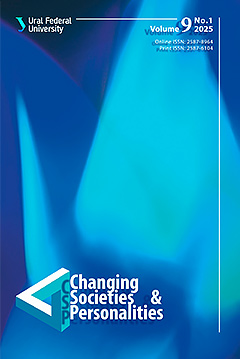Cyberfield: Theory, Methodology, and Practice
Abstract
The study of digital identity began in the late 1980s with the rise of computers, the Internet, video games, and online communication tools. Over the past 35 years, digital anthropology and ethnography have provided valuable insights into virtual interactions. However, due to rapid technological advancements, researchers must continually update their methodologies to stay aligned with new trends in online communication. This study seeks to explore and systematize theories, methodologies, and practices related to the cyberfield, offering a comprehensive understanding of current research in digital ethnography. Additionally, it introduces an alternative methodology for analyzing the cyberfield, emphasizing its advantages in capturing the complexities of online spaces. The methodological principles outlined in this article are illustrated through examples from the authors’ own study of the ethnic identity of minor Indigenous peoples in Russia in the online environment. Today, virtual spaces offer various research opportunities, including qualitative and quantitative methods, surveys, and database creation, enhancing data collection. Web analysis has simplified fieldwork by reducing the need for physical presence, saving time and resources. However, recent developments suggest that real-world interaction remains crucial. The growing intersection of the “digital” and “physical” fields highlights the importance of integrating both contexts in ethnographic research for a more nuanced understanding of virtual and real-world experiences.
References
- Abidin, C., & de Seta, G. (2020). Private messages from the field: Confessions on digital ethnography and its discomforts. Journal of Digital Social Research, 2(1), 1–19. https://doi.org/10.33621/jdsr.v2i1.35
- Androutsopoulos, J. (2008). Potentials and limitations of discourse-centred online ethnography. Language@Internet, 5, Article 9.
- Baym, N. K. (2009). What constitutes quality in qualitative internet research. In A. N. Markham & N. K. Baym (Eds.), Internet inquiry: Conversations about method (pp. 173–189). SAGE. https://doi.org/10.4135/9781483329086.n16
- Belorussova, S. (2016, March 27). Ash biru u nagaibakov [Ash Biru of the Nagaybaks] [Video]. Youtube. https://www.youtube.com/watch?v=O5IYmhALzs8
- Belorussova, S. Yu. (2018, March 26). Dorogie moi nagaibaki! Obrashchaius’ s pros’boi. V Sankt-Peterburge ia poznakomilas’ s pravnuchkoi Ivana Georgievicha Isaeva—kazaka, generala, voennogo gubernatora Vil’niusa [My dear Nagaibaks! I am writing to you with a request. In St. Petersburg I met the great-granddaughter of Ivan Georgievich Isaev, a Cossack, general, military governor of Vilnius] [Images attached]. Odnoklassniki. https://ok.ru/profile/120638682250/statuses/68012065726602
- Belorussova, S. Yu. (2021). Kiberetnografiia: Metodologiia i tekhnologiia [Cyberethnography: Methodology and technology]. Etnografia, 3, 123–145. https://doi.org/10.31250/2618-8600-2021-3(13)-123-145
- Belorussova, S. Yu. (2022). Korennye malochislennye narody Rossii: Virtual’naia etnichnost’ i setevye opyty [Indigenous small-numbered peoples of Russia: Virtual ethnicity and network experiences]. Etnografia, 4, 84–111. https://doi.org/10.31250/2618-8600-2022-4(18)-84-111
- Belorussova, S. Yu. (2023a). Ischezaiut li nagaibaki? [Are Nagaibaks disappearing?]. Etnografia, 1, 203–224. https://doi.org/10.31250/2618-8600-2023-1(19)-203-224
- Belorussova, S. Yu. (2023b, December 20). Dorogie besermiane! Seichas ia provozhu issledovanie deiatel'nosti besermian v sotsial'nykh setiakh. Otvet'te, pozhaluista, na korotkie voprosy ankety. Eto pomozhet [Dear Besermyans! Now I am conducting a study of Besermyan activity in social networks. Please answer the short questions of the questionnaire. This will help]. [Image attached]. VK. https://vk.com/wall3992144_3779
- Belorussova, S. Yu. (2023c, January 12). Na proshloi nedele prishli rezul’taty perepisi 2020 g. po natsional’nomu sostavu naseleniia Rossii. Po korennym malochislennym narodam vrode vse neplokho—chislennost’ [Last week, the results of the 2020 census on the national composition of Russia’s population came in. The number of minor Indigenous peoples seems to be good—the number] [Image attached]. VK. https://vk.com/wall3992144_3719
- Belorussova, S. Yu., Danilova, E. N., & Sysoeva., M. E. (2020). Kheshtegi i etnichnost [Hashtags and ethnicity]. Etnografia, 3, 33–61. https://doi.org/10.31250/2618-8600-2020-3(9)-33-61
- Belorussova, S. Yu., & Khokholkova, N. E. (2023). Virtual’nost’ i global’nost’ (na primere korennykh narodov Rossii i Afriki) [The virtual and the global: Indigenous peoples of Russia and Africa in digital environment]. Etnografia, 4, 160–180. https://doi.org/10.31250/2618-8600-2023-4(22)-160-180
- Boellstorff, T. (2015). Coming of age in Second Life: An anthropologist explores the virtually human. Princeton University Press.
- de Seta, G. (2020). Three lies of digital ethnography. Journal of Digital Social Research, 2(1), 77–97. https://doi.org/10.33621/jdsr.v2i1.24
- Fine, G. A. (1993). Ten lies of ethnography: Moral dilemmas of field research. Journal of Contemporary Ethnography, 22(3), 267–294. https://doi.org/10.1177/089124193022003001
- Gatson, S. N. (2012). The methods, politics, and ethics of representation in online ethnography. In N. K. Denzin & Y. S. Lincoln (Eds.), Collecting and interpreting qualitative materials (4th ed., pp. 245–275). SAGE.
- Golovnev, A. V. (2020). Kiberskorost’ [Cyberspeed]. Etnografia, 3, 6–32. https://doi.org/10.31250/2618-8600-2020-3(9)-6-32
- Golovnev, A. V., Belorussova, S. Yu., & Kisser, T. S. (2021). Virtual’naia etnichnost’ i kiberetnografiia [Virtual ethnicity and cyberethnography]. MAE RAS.
- Hine, C. (2000). Virtual ethnography. SAGE. https://doi.org/10.4135/9780857020277
- Markham, A. (2012). Fabrication as ethical practice: Qualitative inquiry in ambiguous Internet contexts. Information, Communication & Society, 15(3), 334–353. https://doi.org/10.1080/1369118x.2011.641993
- Miller, D., Costa, E., Haynes, N., McDonald, T., Nicolescu, R., Sinanan, J., Spyer, J., Venkatraman, S., & Wang, X. (2016). How the world changed social media. UCL Press. https://doi.org/10.14324/111.9781910634493
- Miller, D., & Slater, D. (2020). The Internet: An ethnographic approach. Routledge. https://doi.org/10.4324/9781003087007
- Poster, M. (1998). Virtual ethnicity: Tribal identity in an age of global communications. In S. G. Jones (Ed.), Cybersociety 2.0: Revisiting computer-mediated communication and community (pp. 184–211). SAGE. https://doi.org/10.4135/9781452243689.n7
- Snodgrass, J. G. (2014). Ethnography of online cultures. In H. R. Bernard & C. C. Gravlee (Eds.), Handbook of methods in cultural anthropology (2nd ed., pp. 465– 495). Rowman & Littlefield.











